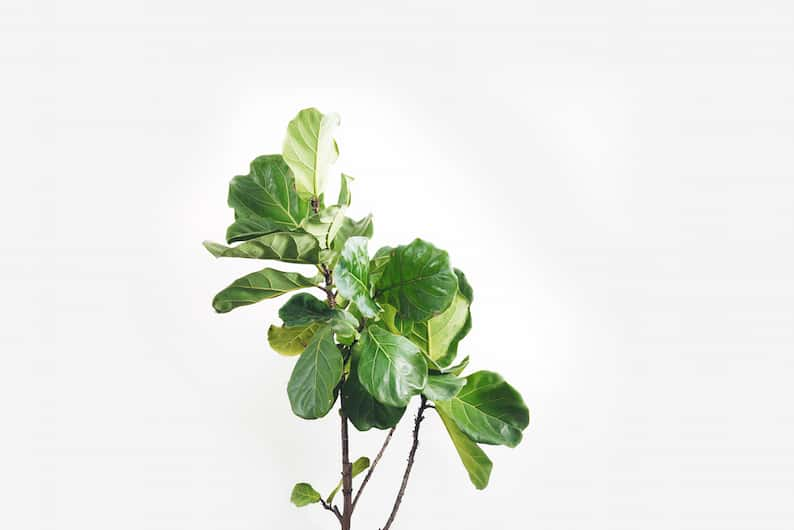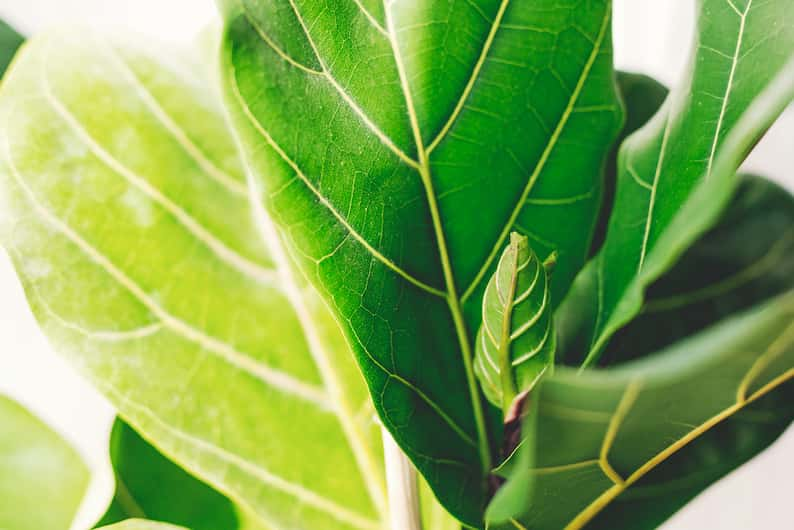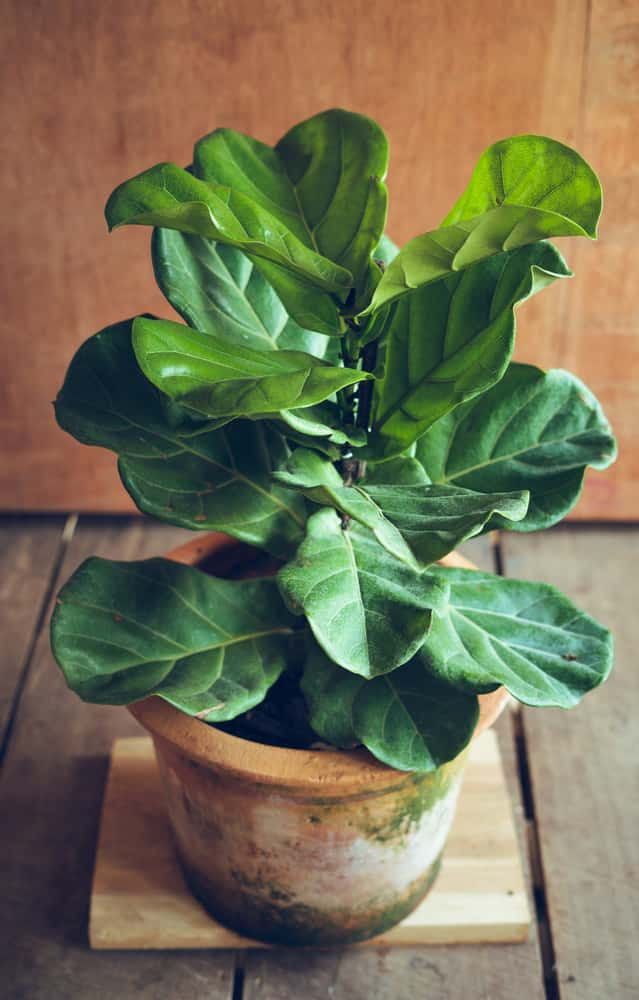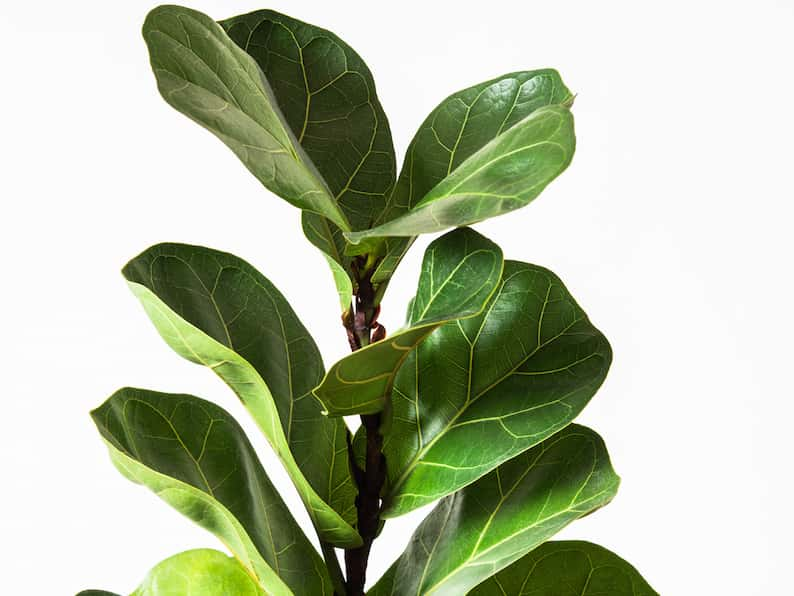When your plant is renowned for its large, luscious leaves, one of the worst things that can happen is to notice your fiddle leaf fig’s leaves are falling off. After all, its foliage is probably the very reason you added this beautiful plant to your collection – so your fiddle leaf fig losing leaves is probably the last thing you want!
Well, never fear. While a fiddle leaf fig dropping leaves isn’t ideal, I’ll show you exactly why this is happening – and, importantly, how to fix it.
And before you know it, your Ficus will soon be back to its happy, thriving self!

Table of Contents
Why are my fiddle leaf fig’s leaves falling off?
The fiddle leaf fig can be temperamental and react by dropping its leaves when its growing preferences are not met. It can drop its leaves for many reasons, but these are the most common.
- Overwatering. Overwatering is one of the most common reasons why a fiddle leaf fig is dropping leaves, although this will likely come after its leaves develop large, dark brown spots. When this happens, the leaves eventually die off and drop from the plant. This can progress to dreaded root rot if not corrected promptly.
- Improper drainage. This is related to overwatering, in that your fiddle leaf fig leaves could be falling off due to your plant’s pot retaining too much moisture. To avoid this, check that the soil in your fiddle leaf fig pot drains properly and does not remain soggy. Let the top 2 to 3 inches of the soil dry before watering your fiddle leaf fig plant.
- Underwatering. Under watered fiddle leaf fig plants typically develop light brown edges along the margins of the leaves. They turn dry and crispy and often begin to curl, with the leaves eventually dying off, leading to your fiddle leaf fig losing leaves. To avoid this, water your fiddle leaf fig when the top 2 to 3 inches of the soil feels dry, but do not let it dry out completely.
- Not enough light. In terms of their light requirements, fiddle leaf figs need 6 hours of direct sunlight a day and suffer in low light, with other signs of this also including if your fiddle leaf fig is drooping. If your fiddle leaf fig is losing leaves from lack of light, place it near a western or southern window that receives direct sunlight. Northern and eastern windows do not typically provide enough light for your fiddle leaf fig.
- Hot or cold drafts. Fiddle leaf figs are sensitive to both hot and cold drafts and may show their discomfort by dropping their leaves. Place your plant in a draft-free area away from leaky windows and doors. Likewise, avoid areas near heating or AC vents.
- Improper temperatures. Fiddle leaf figs prefer a temperature between 60 and 75 degrees and suffer if the temperature drops or rises outside of that range. If your fiddle leaf fig is dropping its leaves for apparently no reason, monitor the temperature closely to ensure high or low temperatures are not the cause.
- Stress. Leaf drop is a natural response to stress in many plants, and your fiddle leaf fig is no exception. Stress can be caused by disturbing the plant, moving it to a new location, or simply too much activity near the plant. Place your fiddle leaf fig plant in an area away from foot traffic where it will not be disturbed. Likewise, check that pets or active children are not disturbing the plant while at play (and especially your pets, given that the fiddle leaf fig is toxic to cats).
Will a fiddle leaf fig regrow leaves?
When a leaf dies and drops from your fiddle leaf fig plant, the leaf node dies, too. That means the plant cannot regrow a new leaf in the same spot. But the good news is your fiddle leaf fig has leaf nodes along the stems and can grow new leaves from another node.

That is, while the plant won’t replace the leaf that has dropped, it will grow new leaves to replace it as long as its growing preferences are met and the underlying cause for the leaf drop is addressed. While a fiddle leaf fig with no leaves is definitely a sign of a serious problem with your plant, it’s highly unlikely you’ll get to that point if you’re addressing its basic needs.
Related: How Fast Do Fiddle Leaf Figs Grow?
How do I get more leaves on my fiddle leaf fig?
Healthy fiddle leaf figs produce new leaves regularly on their own and don’t need any special treatment from you. However, to ensure your fiddle leaf fig grows ample leaves, especially if its leaves have been falling off beforehand, you need to provide it with the conditions it needs to thrive.
- Provide enough light. Fiddle leaf figs require 6 hours of direct sunlight a day and so best in western or southern windows.
- Practice good watering techniques. Avoid sticking to a watering schedule and check the moisture in the soil before watering your fiddle leaf fig. In terms of how often you should water a fiddle leaf fig, this plant requires soil that dries out slightly between waterings but will suffer in either dry or wet soil.
- Maintain proper temperatures. Fiddle leaf figs prefer temperatures between 60 and 75 degrees. Avoid growing them in areas where the temperatures fall or rise outside this range.
- Provide a humid environment. As tropical plants, fiddle leaf figs prefer humid air and may suffer in dry air in your home, especially during the winter. Use pebble trays or a humidifier to raise the humidity levels near your plants.
- Use well-draining soil. Well-draining soil is vital to the health of your fiddle leaf fig. It ensures that water drains properly and that it does not remain soggy.
Related: What To Do If Your Fiddle Leaf Fig Is Not Growing New Leaves
Is it normal for a fiddle leaf fig to drop leaves?
Leaves do not live forever and, like most plants, your fiddle leaf fig will commonly drop some old leaves as new leaves form on the plant. This means that some leaf drop is normal in your fiddle leaf fig plant.
If you notice lower leaves turning yellow on your fiddle leaf fig and dropping from the plant occasionally, it is not a cause for concern. It is normal for the plant to shed older leaves as new young leaves grow. Because your fiddle leaf fig produces new growth from the top, the bottom leaves are the oldest.
Your fiddle leaf fig drops some bottom leaves because they are old and no longer needed to provide energy for the plant.

Why is my fiddle leaf fig tree losing leaves in summer?
If your fiddle leaf fig is dropping leaves in the summer, it may be a sign that the temperature is too high or that your plant is drying out excessively in the summer heat. In particular, if the soil dries out too much, your plant will not get the water it needs and may respond by dropping its leaves.
Likewise, if the temperature soars above 75, this could very well be another reason that fiddle leaf fig tree leaves are falling off.
Check that the temperature remains below 75 degrees and that the soil does not dry out completely between watering. You should also make sure your fiddle leaf fig is positioned somewhere where it’s not being blasted by any hot drafts. Allow the top 2 to 3 inches of the soil to dry out before watering your fiddle leaf fig, but do not allow the soil to dry completely.
Why are my fiddle leaf fig leaves turning brown and falling off?
If your fiddle leaf fig leaves are turning brown and falling off, this is often a signal that your plant is under stress. This is commonly due to either under watering or overwatering which, in turn, can lead to root rot. If the problem isn’t fixed quickly and too many leaves fall off, your plant can die from this.
It’s for this reason that checking on your plant from time to time is key. If you notice any brown spots on your fiddle leaf fig, double check that either of the below issues aren’t the problem, as they’re both common culprits when this sign pops up.

Underwatering
Brown leaves from underwatering begin with light brown margins along the edges of the leaves. They often cause your fiddle leaf fig’s leaves to curl as the brown spots become crispy and dry. Brown, crisp or curly leaves occur when the plant does not have enough water to maintain the structure of the leaf.
Check the soil in your fiddle leaf fig plant for signs of under-watering. The soil may be compacted or pulled away from the pot’s sides.
Best soil for Fiddle Leaf Figs
Miracle-Gro Tropical Potting Mix
Light and well-draining (perfect for avoiding root rot) while being packed with just the right nutrients – that will feed your plant for up to six months. The best soil for keeping your fiddle leaf fig healthy and strong.
Over watering
Brown leaves from overwatering your fiddle leaf fig are dark brown and may occupy large leaf sections. When the roots of your fiddle leaf fig sit in soggy soil, they cannot absorb the oxygen and nutrients the plant needs. This causes the foliage to die.
If left unchecked, soggy soil can lead to root rot in your fiddle leaf fig, caused by several fungi that thrive in wet soil. Root rot destroys the roots of your plants, turning them to mush. If not treated quickly, root rot will kill your fiddle leaf fig.
Check the roots of your fiddle leaf fig to determine if root rot is the problem. Healthy roots are firm and pliable and either white or light tan. Discolored or blackened roots that are soft and mushy indicate root rot has set in. Trim away the affected roots and repot your fiddle leaf fig in fresh soil.
Understanding the most common reasons for leaf drop in your fiddle leaf fig will help you troubleshoot the problem when it arises. With proper care and attention to its growing needs, your fiddle leaf fig will thrive in your home, creating a striking display of tropical foliage.
Final thoughts on what to do if your fiddle leaf fig is dropping leaves
Of course, it’s not ideal if your fiddle leaf fig is dropping leaves, but it’s also not the end of the world. If you notice it in time after the first few leaves, you’re giving yourself plenty of time to figure out the problem and rectify it before you get to the point of no return.
As mentioned, it basically comes down to a process of elimination on what’s causing your fiddle leaf fig’s leaves to fall off. And once you narrow down the culprit, it’s as easy as simply making some adjustments to your plant’s maintenance to get your Ficus back to its usual, thriving glory.

